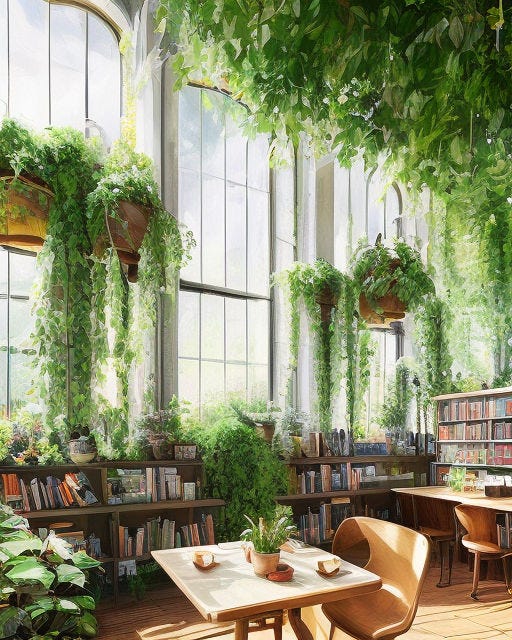Tools for solarpunk speculation
From citizen science to 'Legos of the revolution' this guest post prompts ways to imagine better futures
After his first guest post about solarpunk enterprise ideas explores ways to help imagine solarpunk worlds.
Today I’m bringing you some mental tools which I think could be useful for generating ideas about possible solarpunk futures. Hopefully, these explorations will help folks better envision a more deliciously sustainable future.
AnarchoTech
Don’t be scared by the ‘anarchy’ in the name, the idea here is to simply build technologies in a non-hierarchical manner. The aim is to help people to empower themselves and escape monopolistic forces.
The idea is for technology that helps foster a culture of sustainability through accountability. Where all potential and realized externalities are considered at the forefront. It looks to build ecosystems instead of monocultures, where interoperability and modability are normalized and encouraged. It’s communal to the core, empowering people collectively to be far more autonomous than in our current system.
[The lush side of the tracks IMAGE: Nick Pedersen “Green City”]
Imagine something like free-flowing art. Music players that allow people to download songs from any platform to a personal device. They can then play or remix that music any way they want. Whenever they share their art back out, metatags are sent along with it, and recorded in several other places to show who created it, and what other songs or tools they used in the creation. This same idea can be applied to pretty much any type of art, from movies to visual art to games and so on.
In this thought experiment we would be challenging the current idea of ‘intellectual property’. We could favour of a system of crediting people for their work rather than merely pretending to do so. Instead of building fortresses that only the biggest of companies can afford to erect and defend, we can build connections between people, allowing a more dynamic flow of information and ideas.
A more visceral technology could be a sort of sustainable blockchain, or other type of database. This could allow people to track pollution, ecological harm, and labour used in products. It could be as ‘simple’ as an open-source website where folks anywhere in the world can report these externalities and upload visual evidence. These reports would then follow the product through its whole supply chain and lifecycle. When you search for that product, you can see all the ways it impacts the world.
[AR in the neighbourhood IMAGE: Olalekan Jeyifous]
This database could even be displayed through augmented reality filters. This would allow you to instantly see the real impact of everyday items, from chocolate to cars to computers. This would encourage people to hold companies accountable who claim they are being sustainable, to make truly informed decisions when purchasing, and to motivate people to find better alternatives.
I explore this concept of ‘anarchic technology’ much more in depth in the first part of my article on my own newsletter. Feel free to dive in further here at the Journal of TechnoWizardry
Citizen Science
In recent years there have been efforts to democratize science, and make it more accessible. I’d love to see a world where we have systems and knowledge bases that empower everyday people to learn and do science outside of the lab.
[Borrowing communally IMAGE: @faebymckay]
Imagine local libraries and community centres with freely accessible equipment and research papers. Anybody could come in and learn how to do science regardless of their background or education level. Especially if we gain a shorter working week, we’ll all get lots more time to experiment.
Research papers would be freely accessible, instead of locked-up in institutions. Humans, or even AI, could communicate said papers in a more approachable and even fun way for lay-people to actually understand. This could help them replicate the experiments and studies for themselves.
Common History
One way to look to the future is to draw inspiration from the past. Rather than studying the ‘great man’ theory of history we could look more at past social and popular movements. Though there have been efforts to teach this type of ‘History from Below’ going back decades, it's often been done in a very boring way.
[Power with the people - Lancashire cotton workers showing solidarity with Ghandi IMAGE: BBC]
What if instead, we could teach the history of everyday people in immersive, engaging, and diverse mediums? We could have fun videos, podcasts, movies and even virtual reality simulations. These could depict everything from folktales to interesting anthropological and archaeological findings, to recreations of past technologies. These would be constantly updated, stimulating, and sourced from historical data across the world.
Imagine learning about how everyday people lived in ancient foraging cultures, or during the middle ages, or in pre-colonial Africa through realistic simulations and engaging documentaries.
We could even have real-world locations that are a combination of theme parks, historical towns, schools and nature preserves where people could relive those times. Not only with the goal of escapism or entertainment, but to seek ideas for how we might live now from traditions we’ve forgotten to remember.
Legos of the Revolution
The idea here is that we could have a repository of tools and information in the form of building blocks. These could allow us to build our own idea of the future using pieces of past societal transformations, perhaps in new and innovative combinations.
Imagine being able to see what large-scale change would look like if you put together the consensus-building governance models of egalitarian cultures like the Iroquois, with the tech-driven voting of the Netherlands, combined with the gift economies of pre-colonial societies, and even throw in the analytical skepticism that started the scientific revolution.
[Playing with new worlds IMAGE: Amelie Mourichon via Unsplash]
You could test the compatibility of these pieces to see how they may, or may not, create the future you are looking to build.
This could resemble something like a cross between the 200 point-system of B-Corp applications, with the economic analysis of advanced business plans, wrapped in an engaging virtual environment like the Kerbal Space Program or Universe Sandbox. This could allow people to create a model of whatever future or organization they have in mind to see how it might look, feel, and function if created, all while having fun.
These are just a few ideas of tools we could use to think more broadly about what solarpunk societies could be like.
If you’d like to get much more into the weeds with these ideas, check out my Journal of TechnoWizardry version of this article. There I delve deeper into all of these and so much more. Be warned though I tend to write very long-form content, especially when it comes to exploring exciting new ideas like these!
I’d love to hear from you. What do you think off these tools for imagining things differently? Are there any others you would add?
Would you like to do a guest post for us? If so please email us on solarpunkstories@gmail.com with your ideas. We’d love to hear them.
Until Next Time
That's all for this update. If you like what we’re trying to do here and know someone else who might do too then please like, comment and share.
See you in the sunshine,
Alex Holland
Founder, SolarPunk Stories










Thanks so much for giving me the opportunity to share a few of my ideas on this awesome newsletter!! The solarpunk movement is such a fantastic and fascinating attempt at actionable optimism, and I'm excited to help however I can.
Looking forward to future issues, other guests, and more delicious futures to come!
“Deliciously sustainable future” is such a super phrase! Thank you for this article, which is jam-packed with ideas of how we could do things differently. I’ll admit I was challenged by the suggestion of dissolution of IP, but after sitting with it awhile I can see how the IP model of art is deeply problematic. Capitalism needs to commodify everything, even our most beautiful creations, and that isn’t benign. Thank you for making me think!